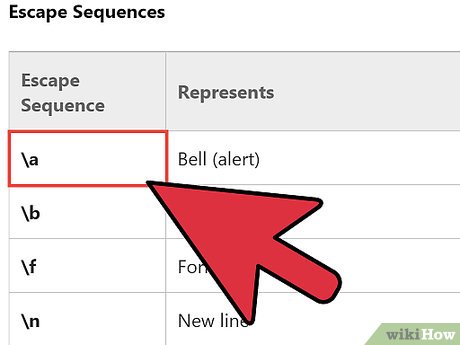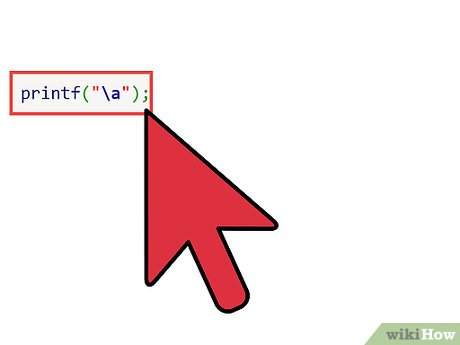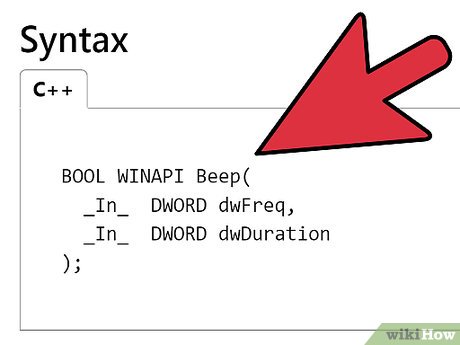How to Create an Alert in C
Part 1 of 3:
Character alert
-
 If you want your alert to be portable and work on every computer, you can use the escape code "a".
If you want your alert to be portable and work on every computer, you can use the escape code "a".- a is defined as an audible alert, usually a beep. [1] However, on some Unix operating systems it might produce a screen flash instead of a sound.
-
 Use this example code.
Use this example code.printf("a");
Part 2 of 3:
Beep()
-
 On Windows operating systems, you can use the Beep(int frequency, int ms). It makes a beep of a specified duration and frequency.[2]
On Windows operating systems, you can use the Beep(int frequency, int ms). It makes a beep of a specified duration and frequency.[2]- On the Windows7 operating system, this function sends the beep to the sound card. This works only if the computer has speakers or headphones.
- On previous Windows versions, it sends the beep to the motherboard. This works on most computers and no external devices are required.
-
 Include the windows library. Add the following code at the beginning of your program:
Include the windows library. Add the following code at the beginning of your program:#include - When you need a beep, use the following code:
Beep(500, 500);
-
 Change the first number with the frequency of the beep you want. 500 is close to the beep you get with a.
Change the first number with the frequency of the beep you want. 500 is close to the beep you get with a. - Change the second number with the duration of the beep in milliseconds. 500 is a half of a second.
Part 3 of 3:
Sample Code
-
 Try a program that uses a to make a beep when a key is pressed, uses ESC to exit:
Try a program that uses a to make a beep when a key is pressed, uses ESC to exit:#include #include int main() { while(getch() != 27) // Loop until ESC is pressed (27 = ESC) printf("a"); // Beep. return 0; }
-
 Try a program that makes a beep of a given frequency and duration:
Try a program that makes a beep of a given frequency and duration:#include #include int main() { int freq, dur; // Declare the variables printf("Enter the frequency (HZ) and duration (ms): "); scanf("%i %i", &freq, &dur); Beep(freq, dur); // Beep. return 0; }
3.5 ★ | 2 Vote
You should read it
- How to create a frequency chart in Excel
- How to change the Maximum processor frequency setting in Windows 10
- FREQUENCY function - Function that calculates and returns the frequency of occurrences of values in a range in Excel
- How to use the maximum screen scan frequency in Windows 10
- 5 reasons to convince you to use high-frequency rice cooker
- Why does the wifi wave have the same frequency as the microwave but doesn't 'cook' anything?
- Tips to make the most of the image refresh rate on your computer screen
- How to Hook up a Crossover
May be interested
- Twitter iOS tests the inappropriate language alert feature
 social network twitter is testing a new feature to restrict users from using messages containing harmful language.
social network twitter is testing a new feature to restrict users from using messages containing harmful language. - Tutorial from AZ how to create Google Alerts query tool
 google alerts is a google service that allows you to update search results related to a certain keyword via email. when using google alert, you will be able to track your competitors on the same keywords and you will know what efforts they are making and take the necessary measures for your keywords.
google alerts is a google service that allows you to update search results related to a certain keyword via email. when using google alert, you will be able to track your competitors on the same keywords and you will know what efforts they are making and take the necessary measures for your keywords. - How to Code an Alert with a Variable Using Javascript
 alerts with variables are among the most useful things in javascript coding. you can use them to refer to someone by their name, to make a mini madlibs game, or even for showing quiz results. this article will show you how to make a...
alerts with variables are among the most useful things in javascript coding. you can use them to refer to someone by their name, to make a mini madlibs game, or even for showing quiz results. this article will show you how to make a... - How to nap scientifically for a healthy and alert body
 many people after the afternoon nap feel tired as if they were drained of energy. so how much nap is science, how much sleep is enough, how to sleep properly to help you stay fit and alert to continue your work?
many people after the afternoon nap feel tired as if they were drained of energy. so how much nap is science, how much sleep is enough, how to sleep properly to help you stay fit and alert to continue your work? - How to turn off Viber message notification sound on Android
 turning off the viber message alert on your phone lets you leave your phone ringing without sounding messages from viber disturbing, annoying others while meeting or working.
turning off the viber message alert on your phone lets you leave your phone ringing without sounding messages from viber disturbing, annoying others while meeting or working. - Google Alert is being used to spread malicious code
 by using fake data leak notifications, hackers have taken advantage of google alert itself to spread malware and other phishing campaigns.
by using fake data leak notifications, hackers have taken advantage of google alert itself to spread malware and other phishing campaigns. - Create an audible alert when the GPU temperature gets too high
 instructions on how to create warnings when the gpu temperature gets too high with gpu monitor software. the trick generates an audible alarm when the temperature exceeds the allowable threshold
instructions on how to create warnings when the gpu temperature gets too high with gpu monitor software. the trick generates an audible alarm when the temperature exceeds the allowable threshold - Why are people staying up late often smart and alert?
 science proves: people who stay up late are often more intelligent and alert.
science proves: people who stay up late are often more intelligent and alert. - Foods that make you more alert than drinking coffee
 to start a sobering day, many people often choose for themselves a cup of coffee to sip this special drink. however, to be alert, coffee is not necessarily the only option for you. you can skip coffee to find yourself healthier foods that are not inferior to coffee at all.
to start a sobering day, many people often choose for themselves a cup of coffee to sip this special drink. however, to be alert, coffee is not necessarily the only option for you. you can skip coffee to find yourself healthier foods that are not inferior to coffee at all. - Checking Exchange Server 2007 with MOM 2005 (Part 3)
 mom 2005 administration interface: analysis of exchange server 2007 management pack changes. mom uses 3 types of data discrimination: event (event), alert (alert) and performance counter to check and save exchange server information.
mom 2005 administration interface: analysis of exchange server 2007 management pack changes. mom uses 3 types of data discrimination: event (event), alert (alert) and performance counter to check and save exchange server information.

















 How to Calculate Your Wage in C++
How to Calculate Your Wage in C++ How to Set Up SFML in a Project on Visual Studio
How to Set Up SFML in a Project on Visual Studio How to Create Pointers in C
How to Create Pointers in C How to Set Up OpenGL‐GLFW‐GLAD on a Project with Visual Studio
How to Set Up OpenGL‐GLFW‐GLAD on a Project with Visual Studio How to Write to a Text File in C++
How to Write to a Text File in C++ How to Run C/C++ Program in Netbeans on Windows
How to Run C/C++ Program in Netbeans on Windows